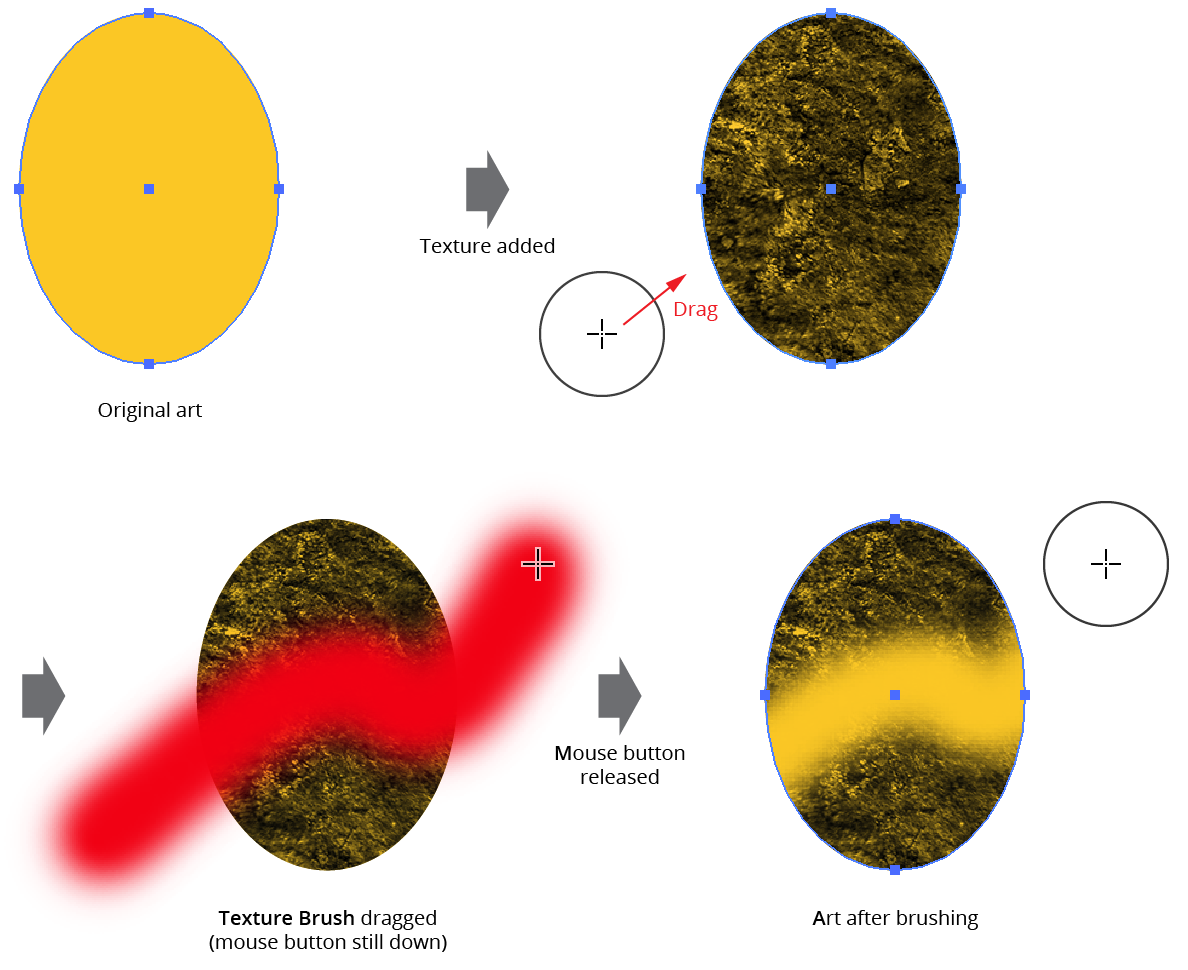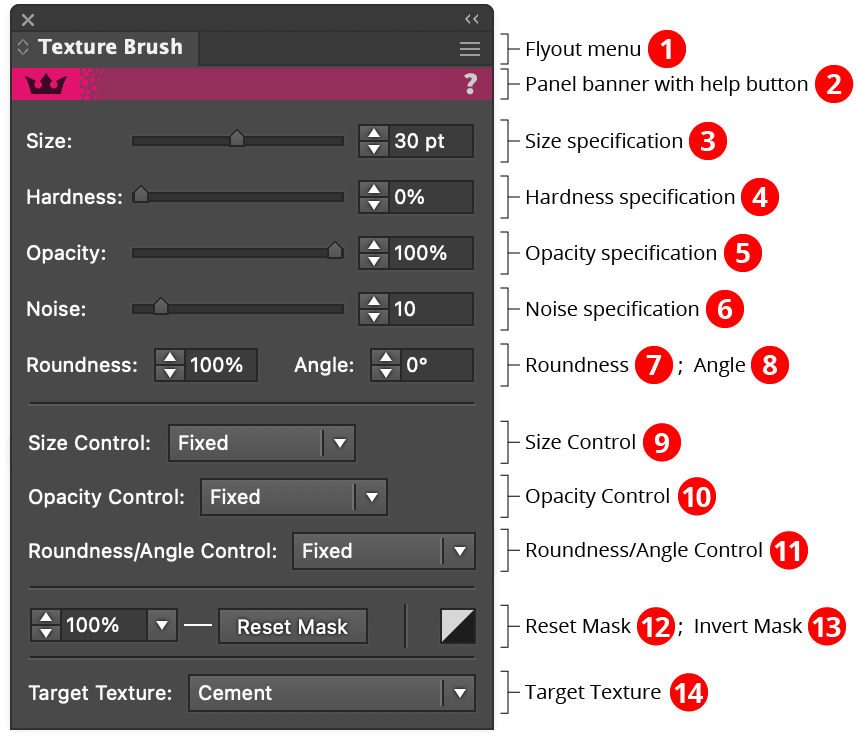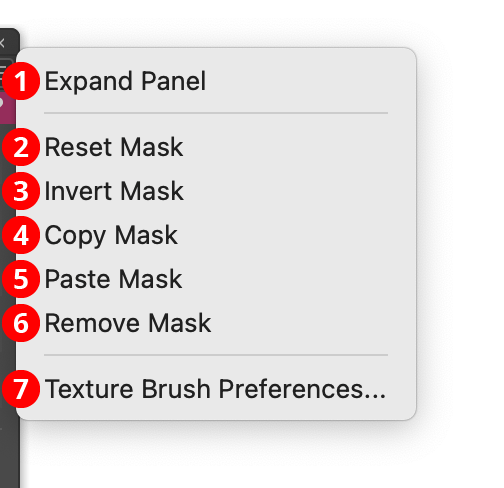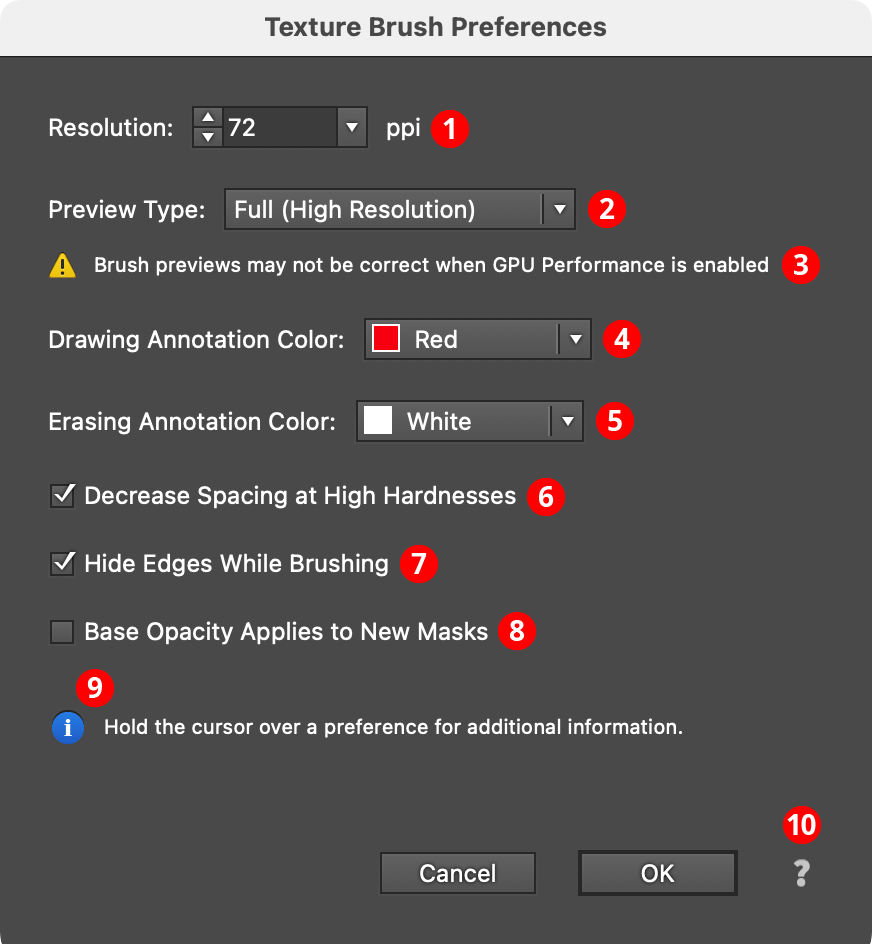 Texture Brush
Texture Brush
Texture Brush is an Astute Graphics tool for Adobe Illustrator that allows local changes to the opacity of a Astute Texture live effect (using an opacity mask) through a brush interface. The brush has variable size, opacity, hardness, roundness, noise, and angle, and has pressure support for an input device like a Wacom stylus. Brush parameters and other operations such as inverting or resetting the texture’s opacity mask are controlled through an associated panel. Texture Brush is part of the Texturino plugin.
Texture Brush Tool
Tool Location and Cursor Appearance
The Texture Brush tool appears in Illustrator’s main toolbar (which must be in Advanced mode: View > Toolbars > Advanced), stacked the associated Texture tool. As with other stacked tools, click and hold on the top tool icon to display the tools stacked under it.

Texture Brush Tool Location
The Texture Brush tool’s cursor is a crosshair. When the tool is not actively brushing, or when brush previews are disabled, it also displays a dark gray circle (or ellipse) indicating the size and shape of the brush:

Texture Brush Tool Cursors
A minus sign symbol indicates that the brush is in “erasing” mode.
Texture Brush Tool Operation
As the Texture Brush tool has several keypresses which can add or change its functionality, we suggest installing the free Astute Graphics plugin Astute Buddy, which creates a panel that dynamically updates to inform you of the various keys which can be pressed in the tool’s current context.
While the Texture Brush tool can be used without its panel, some functionality, such as adjusting the amount of noise, requires the panel to access.
As initially applied, a Texture live effect only has an overall opacity. However, you may want the texture to fade out in certain areas, perhaps to achieve a more three-dimensional look, or to make overlaid text more legible. While the Texture effect could be expanded and an opacity mask created manually, it is much easier to simply use the Texture Brush and “brush” the opacity changes directly onto the texture. Within the live effect, this adds an opacity mask, with a default resolution of 72ppi, but the value can be changed in the tool Preferences dialog (see Texture Brush: Preferences).
With at least one object with a Texture live effect selected, dragging the Texture Brush tool over visible parts of the texture reduces its opacity (if the Texture Brush opacity is set to 100%, the texture’s opacity will be reduced by 100%, i.e., completely removing it).

Texture Brush Example
The Texture Brush tool’s preview can be changed in its preferences; by default, it is red and shows its size, hardness, and opacity faithfully, similar to how a Photoshop brush would draw. Due to technical limitations of Illustrator, this requires CPU preview to be enabled in order to display properly when brushing long distances.
If the Option/Alt key is held down before brushing, the tool will be set to “erasing” mode, whereby each brush stroke adds opacity to the texture (up to a maximum of 100%), instead of removing it. Like other brush tools, the diameter of the brush can be changed at any time it is active by pressing the keys assigned in the native Keyboard Shortcuts dialog to “Decrease Diameter” and “Increase Diameter.” For English language installations, these default to the open square bracket and close square bracket keys ([ and ]).
Another way to change the brush diameter (and hardness) is to hold down Shift-Option/Alt and click-drag the mouse; this adjusts the diameter. After releasing Shift-Option/Alt (and with the mouse button still down), a second drag will adjust the hardness.
While brushing (i.e., with the mouse button down), several keypresses can be used:
Shift: Constrains the brush motion to the nearest increment of 45° around the general constrain angle.
Left/Right Arrow: Decreases or increases the brush diameter.
0–9: Sets the brush opacity. 1 sets the opacity to 10%, 2 to 20%, etc.
D: Changes the drawing annotation color, cycling through red, blue, magenta, green, black, and white.
E: Changes the erasing annotation color, cycling through red, blue, magenta, green, black, and white.
To reset, invert, or remove the opacity mask created by the Texture Brush tool, use the Texture Brush panel.
Texture Brush Panel
The menu item to show and hide the Texture Brush panel can be found in the main menu under Window > Astute Graphics > Texture Brush.

Texture Brush Panel
1. Flyout menu
See Texture Brush Panel: Flyout Menu.
2. Panel banner
The help button on the right opens the help documentation in the Astute Manager. If this does not automatically appear, please ensure your Astute Manager is running first.
Click on the other area of the color bar to activate the Texture Brush tool. This is a quick method of locating the tool within the default Advanced toolbar or a custom toolbar.
3. Size Specification
The size (diameter) of the brush, from 1pt to 1000pt.
4. Hardness Specification
The hardness of the brush, from 0% to 100%.
5. Opacity Specification
The opacity of the brush, from 0% to 100%.
6. Noise Specification
The amount of noise in the brush, from 0 (no noise) to 100 (maximum noise).
7. Roundness
The roundness of the brush, from 10% (highly elliptical) to 100% (circular).
8. Angle
When the brush is not at 100% roundness, the angle of the major axis of its elliptical shape.
9. Size Control
Visible when the panel is expanded. When using a mouse as the input device, it should be set to Fixed; otherwise, enables the brush size to be controlled by either the pressure or wheel setting of a stylus-like device.
10. Opacity Control
Visible when the panel is expanded. When using a mouse as the input device, it should be set to Fixed; otherwise, enables the brush opacity to be controlled by either the pressure or wheel setting of a stylus-like device.
11. Roundness/Angle Control
Visible when the panel is expanded. When using a mouse as the input device, it should be set to Fixed; otherwise, enables the brush opacity to be controlled by either the tilt/bearing or tilt/rotation setting of a stylus-like device.
12. Reset Mask
Visible when the panel is expanded. The value input specifies the base opacity of the entire mask when it is reset (or first created, if the tool preference Base Opacity Applies to New Masks is enabled), with a default of 100%. The Reset Mask button resets the mask, removing all existing brush strokes that may have been made to it and filling it with the base opacity specified in the value input box.
13. Invert Mask
Visible when the panel is expanded; inverts the texture opacity mask.

Texture Brush Panel Invert Mask
14. Target Texture
When multiple textures exist in the selected art object, or multiple objects are selected, the Target Texture menu controls which texture’s masks will be affected (each texture has its own independent opacity mask). By setting the popup menu to All Visible, all tool and panel operations (brushing, resetting, and inverting the mask) will be applied to the mask of every visible texture. Otherwise, these operations will be applied only to the specific texture chosen in the menu (if a single object is selected) or to the topmost visible textures (if multiple objects are selected).
Texture Brush Panel Flyout Menu

Texture Brush Panel Flyout Menu
1. Expand/Compact Panel
When expanded, the panel shows the size control, opacity control, roundness/angle control, reset mask area, and invert mask button.
2. Reset Mask
Resets the texture mask(s), just as clicking the Reset Mask button on the panel would.
3. Invert Mask
Inverts the texture mask(s), just as clicking the Invert Mask button on the panel would.
4. Copy Mask
Copies the texture mask to an internal clipboard. If multiple masks are selected, only the topmost mask is copied.
5. Paste Mask
Replaces the currently selected mask(s) with the texture mask that is in the internal clipboard. If the mask in the clipboard has different dimensions than a current mask, it is stretched to fit.
6. Remove Mask
Removes the currently selected mask(s), thereby restoring any selected Texture live effects to the state they had before they were brushed or had a mask pasted in.
7. Texture Brush Preferences...
Brings up the Preferences dialog (see Texture Brush: Preferences).
Texture Brush Preferences
Using the flyout menu of the Texture Brush panel, doubleclicking the Texture Brush tool in the toolbox, or pressing the Enter key when the tool is selected will bring up the Texture Brush preferences dialog:

Texture Brush Preferences
1. Resolution
Specifies the resolution of any new internal opacity masks which are created by brushing with the Texture Brush tool (existing masks are not affected). The value can range from 1ppi (pixels per inch) to 2400ppi, with a default of 72ppi.
2. Preview Type
Specifies the type of preview which the Texture Brush tool will display, from among None, Radius Only, Radius and Hardness Only, Full (Medium Resolution), and Full (High Resolution). Full previews may be somewhat slower than the other options, depending on brush size and computer capability.
3. Brush Preview Warning
Due to technical limitations of Illustrator, previews will not display correctly when brushing long distances when GPU Performance is enabled. It is recommended to use CPU preview when brushing with the Texture Brush tool.
4. Drawing Annotation Color
Specifies the color of the brush preview when drawing normally, from among red, blue, magenta, green, black, and white.
5. Erasing Annotation Color
Specifies the color of the brush preview when in erasing mode, from among red, blue, magenta, green, black, and white.
6. Decrease Spacing at High Hardness
When enabled, brush spacing will be lowered when its hardness increases, in order to avoid scalloping along the edges of the brush’s path.
7. Hide Edges While Brushing
When enabled, Illustrator’s annotations indicating the edges of the selection will be automatically hidden during the brushing operation.
8. Base Opacity Applies to New Masks
When enabled, the base opacity value from the reset mask area of the panel will be used not just when resetting masks, but also when a new mask is initially created (that is, when a Texture effect is first brushed).
9. Informational area
Shows a brief description of each preference control when the cursor is being hovered over it.
10. Help Button
Opens the help documentation in the Astute Manager. If this does not automatically appear, please ensure your Astute Manager is running first.
